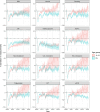Routine measurement of cardiometabolic disease risk factors in primary care in England before, during, and after the COVID-19 pandemic: A population-based cohort study
- PMID: 39591388
- PMCID: PMC11593757
- DOI: 10.1371/journal.pmed.1004485
Routine measurement of cardiometabolic disease risk factors in primary care in England before, during, and after the COVID-19 pandemic: A population-based cohort study
Abstract
Background: This study estimated to what extent the number of measurements of cardiometabolic risk factors (e.g., blood pressure, cholesterol, glycated haemoglobin) were impacted by the COVID-19 pandemic and whether these have recovered to expected levels.
Methods and findings: A cohort of individuals aged ≥18 years in England with records in the primary care-COVID-19 General Practice Extraction Service Data for Pandemic Planning and Research (GDPPR) were identified. Their records of 12 risk factor measurements were extracted between November 2018 and March 2024. Number of measurements per 1,000 individuals were calculated by age group, sex, ethnicity, and area deprivation quintile. The observed number of measurements were compared to a composite expectation band, derived as the union of the 95% confidence intervals of 2 estimates: (1) a projected trend based on data prior to the COVID-19 pandemic; and (2) an assumed stable trend from before pandemic. Point estimates were calculated as the mid-point of the expectation band. A cohort of 49,303,410 individuals aged ≥18 years were included. There was sharp drop in all measurements in March 2020 to February 2022, but overall recovered to the expected levels during March 2022 to February 2023 except for blood pressure, which had prolonged recovery. In March 2023 to March 2024, blood pressure measurements were below expectation by 16% (-19 per 1,000) overall, in people aged 18 to 39 (-23%; -18 per 1,000), 60 to 79 (-17%; -27 per 1,000), and ≥80 (-31%; -57 per 1,000). There was suggestion that recovery in blood pressure measurements was socioeconomically patterned. The second most deprived quintile had the highest deviation (-20%; -23 per 1,000) from expectation compared to least deprived quintile (-13%; -15 per 1,000).
Conclusions: There was a substantial reduction in routine measurements of cardiometabolic risk factors following the COVID-19 pandemic, with variable recovery. The implications for missed diagnoses, worse prognosis, and health inequality are a concern.
Copyright: © 2024 Ho et al. This is an open access article distributed under the terms of the Creative Commons Attribution License, which permits unrestricted use, distribution, and reproduction in any medium, provided the original author and source are credited.
Conflict of interest statement
NS has consulted for and/or received speaker honoraria from Abbott Laboratories, Amgen, AstraZeneca, Boehringer Ingelheim, Eli Lilly, Hanmi Pharmaceuticals, Janssen, Merck Sharp & Dohme, Novartis, Novo Nordisk, Pfizer, Roche Diagnostics, and Sanofi; and received grant support paid to his University from AstraZeneca, Boehringer Ingelheim, Novartis, and Roche Diagnostics outside the submitted work. JV was National Clinical Director for Diabetes and Obesity at NHS England from 2013 to September 2023. JH received research grants from Amgen, British Heart Foundation, Health and Care Research Wales, and speaker honorarium from Amgen. CD is the Treasurer of European Council for Cardiovascular Research, Association of Physicians of Great Britain and Ireland, Council Member of the European Society of Hypertension, and the Vice President of Scottish Heart & Arterial disease Risk Prevention (SHARP). All other authors declared no potential conflicts of interests.
Figures




References
-
- Dale CE, Takhar R, Carragher R, Katsoulis M, Torabi F, Duffield S, et al.. The impact of the COVID-19 pandemic on cardiovascular disease prevention and management. Nat Med. 2023;1–7. - PubMed
-
- Fisher L, Curtis HJ, Croker R, Wiedemann M, Speed V, Wood C, et al.. Eleven key measures for monitoring general practice clinical activity during COVID-19: A retrospective cohort study using 48 million adults’ primary care records in England through OpenSAFELY. Elife. 2023;12:e84673. doi: 10.7554/eLife.84673 - DOI - PMC - PubMed
-
- Bankhead CR, Lay-Flurrie S, Nicholson BD, Sheppard JP, Gale CP, Liyanage H, et al.. Changes in cardiovascular disease monitoring in English primary care during the COVID-19 pandemic: an observational cohort study. medRxiv. 2020:2020.12. 11.20247742.
-
- Carr MJ, Wright AK, Leelarathna L, Thabit H, Milne N, Kanumilli N, et al.. Impact of COVID-19 restrictions on diabetes health checks and prescribing for people with type 2 diabetes: a UK-wide cohort study involving 618 161 people in primary care. BMJ Qual Saf. 2022;31(7):503–514. doi: 10.1136/bmjqs-2021-013613 - DOI - PMC - PubMed
MeSH terms
Substances
LinkOut - more resources
Full Text Sources
Medical

